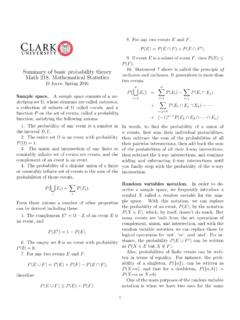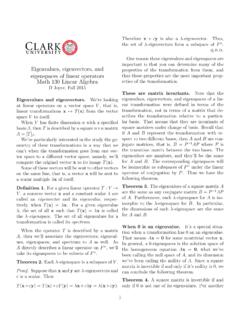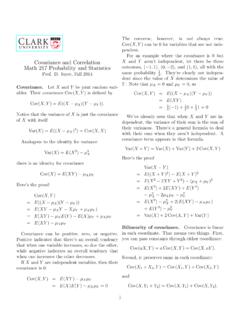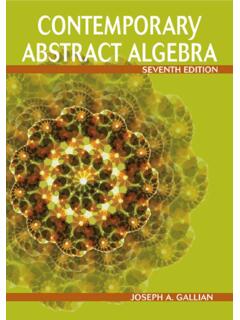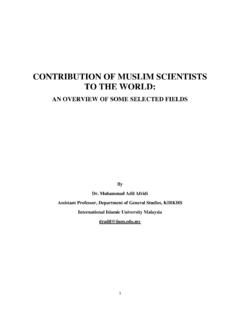Transcription of Introduction to Modern Algebra - Clark University
1 Introduction to Modern AlgebraDavid JoyceClark UniversityVersion , 5 Dec 201711 Copyright (C) 2008, dedicate this book to my friend and colleague Arthur Chou. Arthur encouraged me to writethis book. I m sorry that he did not live to see it was born in 1954 in Taipei, Taiwan. He received his bachelors in mathematicsin 1976 from Tunghai University and his PhD from Stony Brook in 1982. After a year atthe Institute for Advanced Study at Princeton, he joined Clark University in 1983. He waspromoted to Associate Professor six years later and promoted to full professor in 2008, theyear he died. Besides mathematics, he had many other interests. Among other things, he wasthe general manager of the North America Elite Youth Orchestra which performed at Dallas,Beijing, and Taipei, and he was the deacon of the Chinese Gospel Church in Southborough, of FiguresviList of Tablesviii1 Algebra .
2 Structures in Modern Algebra .. on sets .. algebraic structures besides fields, rings, and groups .. Isomorphisms, homomorphisms, etc.. and epimorphisms .. and automorphisms .. A little number theory .. induction on the natural numbersN.. numbers .. Euclidean algorithm .. The fundamental theorem of arithmetic .. Polynomials.. for polynomials .. of unity and cyclotomic polynomials .. 282 Introduction to fields .. of fields .. , division, multiples, and powers .. that follow from the axioms .. of rational functions .. spaces over arbitrary fields .. Cyclic rings and finite fields .. cyclic ringZn.. cyclic prime fieldsZp.. of fields, and prime fields.
3 Field Extensions, algebraic fields, the complex numbers .. fields .. field of complex numbersC.. quadratic extensions .. Real numbers and ordered fields .. fields .. orders .. ordered fields .. Skew fields (division rings) and the quaternions .. fields (division rings) .. quaternionsH.. 513 Introduction to rings .. and properties of rings .. of rings .. domains .. Gaussian integers,Z[i] .. fields again .. FactoringZnby the Chinese remainder theorem .. Chinese remainder theorem .. s solution .. Jiushao s solution .. Boolean rings .. to Boolean rings .. Boolean rings .. partial order on a Boolean ring .. The field of rational numbers, fields of fractions.
4 Categories and the category of rings .. formal definition of categories .. categoryRof rings .. and epimorphisms in a category .. Kernels, ideals, and quotient rings .. of ring homomorphisms .. of a ring .. rings,R/I.. and maximal ideals .. Krull s theorem .. UFDs, PIDs, and EDs .. in an integral domain .. factorization domains .. ideal domains .. domains .. Real and complex polynomial ringsR[x] andC[x] .. [x] and the Fundamental Theorem of Algebra .. polynomial ringR[x] .. Rational and integer polynomial rings .. Roots of polynomials .. Gauss s lemma and Eisenstein s criterion .. Prime cyclotomic polynomials .. Polynomial rings with coefficients in a UFD, and polynomial rings inseveral variables.
5 Number fields and their rings of integers .. 974 Groups and subgroups .. and basic properties of groups .. groups and subgroups .. of groups .. and Lagrange s theorem .. Symmetric GroupsSn.. and the symmetric group .. and odd permutations .. and dihedral groups .. Cayley s theorem and Cayley graphs .. s theorem .. small finite groups .. The category of groupsG.. Conjugacy classes and quandles .. classes .. and the operation of conjugation .. Kernels, normal subgroups, and quotient groups .. of group homomorphisms and normal subgroups .. groups, and projections :G G/N.. theorems .. direct products .. Matrix rings and linear groups .. transformations.
6 General linear groupsGLn(R) .. linear groups .. space and the projective linear groupPGLn(F) .. Structure of finite groups .. groups .. Jordan-H older theorem .. Abelian groups .. categoryAof Abelian groups .. Abelian groups .. 137viCONTENTSA ppendices141A Background Logic and proofs .. Sets .. Basic set theory .. Functions and relations .. Equivalence relations .. Axioms of set theory .. Ordered structures .. Partial orders and posets.. Lattices .. Boolean algebras.. Axiom of choice .. Zorn s lemma .. Well-ordering principle .. 159 Index161 List of Equilateral triangle with lines of symmetry .. Unit circleS1.. Divisors of 432 .. Divisibility up through 12.
7 Cyclic ringsZ6,Z19,Z.. Lattice of Gaussian integersZ[i] .. Free Boolean ring on two elements .. Lattice of Eisenstein integers .. Primitive 7throots of unity .. Subgroups ofS3.. Symmetries of a pentagon .. Symmetries of a cube and tetrahedron .. Cayley graph forD5.. Cayley graph forA4.. Distributivity in a involutory quandle .. A conjugacy class in the quaternion group .. The conjugacy class of transpositions inS4.. The Fano planeZ2P2.. The projective planeZ3P2.. Cayley graph of the Frobenius groupF21=C7oC3.. Heptahedron on a torus .. Lattice of the Powerset of 4 elements .. 157viiviiiLIST OF FIGURESList of Composition table for six particular rational functions.
8 Notations in Boolean algebras, set theory, and Boolean rings.. List of small groups .. Standard logical symbols .. 144ixxLIST OF TABLESC hapter AlgebraThe word Algebra means many things. The word dates back about 1200 years ago to partof the title of al-Khw arizm s book on the subject, but the subject itself goes back 4000 yearsago to ancient Babylonia and Egypt. It was about solving numerical problems that we wouldnow identify as linear and quadratic equations. Versions of the quadratic formula were usedto find solutions to those quadratic equations. Al-Khw arizm (ca. 780 ca. 850) codified thealgorithms ( algorithm is a word derived from his name) for solving these equations. Hewrote all his equations out in words since symbolic Algebra had yet to be places in the world also had Algebra and developed various aspects of it.
9 The ancientChinese solved systems of simultaneous linear equations and later developed algorithms tofind roots of polynomials of high degree. Various aspects of number theory were studied inChina, in India, and by Greek Algebra was developed in the 1500s. Symbolic Algebra has symbols for thearithmetic operations of addition, subtraction, multiplication, division, powers, and roots aswell as symbols for grouping expressions (such as parentheses), and most importantly, usedletters for symbolic Algebra was developed in the 1500s, mathematics flourished in the , analytic geometry, and calculus with derivatives, integrals, and series were de-veloped in that became more general and more abstract in the 1800s as more algebraic structureswere invented.
10 Hamilton (1805 1865) invented quaternions (see section ) and Grassmann(1809 1977) developed exterior algebras in the 1840s, both of which led to vector spaces. (Seesection for vector spaces.)Groups were developed over the 1800s, first as particular groups of substitutions or per-mutations, then in the 1850 s Cayley (1821 1895) gave the general definition for a group.(See chapter 2 for groups.)Several fields were studied in mathematics for some time including the field of real numbersthe field of rational number, and the field of complex numbers, but there was no generaldefinition for a field until the late 1800s. (See chapter 2 for fields.)Rings also were studied in the 1800s. Noether (1882 1935) gave general concept of com-mutative ring in 1921 which was later generalized to include noncommutative rings.



